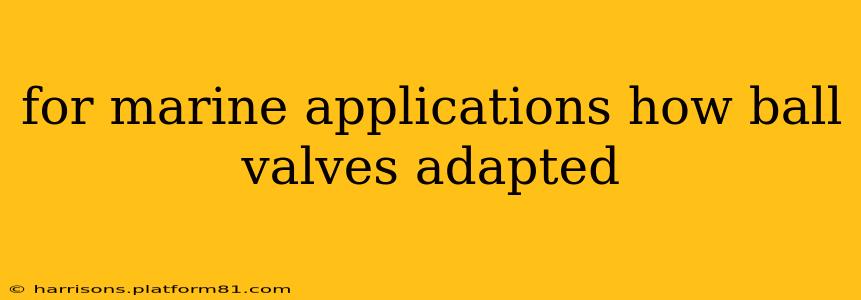Marine environments present unique challenges for any piece of equipment, and ball valves are no exception. The harsh conditions—saltwater corrosion, extreme temperatures, and constant motion—demand specialized adaptations to ensure reliable performance and safety. This article delves into the specific modifications and considerations for ball valves designed for marine applications.
What Makes Marine Ball Valves Different?
Standard ball valves, while robust, lack the necessary resilience for the marine world. The key differences lie in the materials, construction, and testing procedures employed.
Material Selection: The Foundation of Marine Durability
The choice of materials is paramount. Standard ball valves often use brass or less corrosion-resistant materials. Marine ball valves, however, typically utilize:
- 316 Stainless Steel: Highly resistant to corrosion from saltwater and other marine contaminants. Its strength ensures longevity under pressure.
- Duplex Stainless Steels (e.g., Super Duplex): Offer even greater corrosion resistance and strength compared to 316 stainless steel, particularly in highly corrosive environments.
- Special Alloys (e.g., Nickel Alloys): For exceptionally demanding applications, such as those involving high temperatures or highly concentrated corrosive substances.
The seals are equally critical. Marine ball valves often employ:
- PTFE (Polytetrafluoroethylene): A chemically inert polymer providing excellent resistance to chemicals and corrosion.
- EPDM (Ethylene Propylene Diene Monomer): Offers good resistance to many chemicals and a broad temperature range.
The selection of the specific material depends heavily on the application's demands, such as the fluid being handled and the operating pressures and temperatures.
Construction and Design: Enhanced Robustness
Beyond material choice, marine ball valves often feature:
- Reinforced Body Construction: Thicker walls and potentially additional reinforcement ribs provide greater strength to withstand pressure fluctuations and impact.
- Improved Seal Design: Enhanced sealing mechanisms minimize the risk of leakage, crucial for preventing fluid loss and ensuring system integrity. This often includes multiple seal rings or special designs to compensate for wear and tear.
- Robust Actuation Mechanisms: Marine environments demand reliable actuation, whether manual, pneumatic, hydraulic, or electric. These mechanisms must be resistant to corrosion and able to function reliably even in adverse conditions.
Testing and Certification: Meeting Rigorous Standards
Marine ball valves undergo stringent testing to ensure they meet industry standards. These tests might include:
- Pressure testing: To verify the valve's ability to withstand operating pressures and potential pressure surges.
- Corrosion testing: To assess the valve's resistance to saltwater and other corrosive elements.
- Leakage testing: To ensure the valve maintains a tight seal under pressure.
Frequently Asked Questions (PAA)
Here we address some commonly asked questions about marine ball valves:
What are the common applications of marine ball valves?
Marine ball valves find applications across various systems on vessels, including:
- Bilge systems: Controlling the flow of water from the bilge.
- Ballast systems: Managing the flow of water into and out of ballast tanks.
- Fire fighting systems: Precise control of water flow for fire suppression.
- Fuel and lubricating oil systems: Controlling the flow of these crucial fluids.
- Seawater cooling systems: Managing the flow of cooling water.
- Hydraulic systems: Controlling hydraulic fluid flow in various marine systems.
What is the typical lifespan of a marine ball valve?
The lifespan of a marine ball valve depends heavily on the quality of the valve, the materials used, the operating conditions, and the frequency of use. Proper maintenance significantly extends the valve's life. With proper maintenance and selection of high-quality valves, a lifespan of 10-20 years or more is not uncommon.
How are marine ball valves maintained?
Regular inspection and maintenance are crucial. This typically includes:
- Visual inspection: Checking for signs of corrosion, damage, or leaks.
- Lubrication: Applying appropriate lubricants to moving parts, as recommended by the manufacturer.
- Operational testing: Periodically operating the valve to ensure smooth operation.
- Replacement of worn parts: Replacing seals or other components as needed to maintain system integrity.
What are the key differences between marine and industrial ball valves?
While some similarities exist, key differences center around material selection (greater emphasis on corrosion resistance in marine applications), stricter testing standards (to meet marine certification requirements), and design features that enhance resilience to harsh marine environments (such as reinforced construction).
How do I choose the right marine ball valve for my application?
Selecting the appropriate marine ball valve involves careful consideration of several factors:
- Fluid type: The chemical properties of the fluid dictate material compatibility.
- Operating pressure and temperature: The valve must withstand the operating conditions.
- Valve size and flow rate: The valve must handle the required flow.
- Actuation type: Choose manual, pneumatic, hydraulic, or electric actuation based on needs.
- Environmental factors: Account for exposure to saltwater, UV radiation, and other environmental challenges.
Consulting with a valve specialist is highly recommended to ensure the correct valve is selected for the specific application.
This detailed overview should provide a comprehensive understanding of marine ball valves and their specialized adaptations for the demanding conditions of maritime operations. Remember that proper selection, installation, and maintenance are key to maximizing the lifespan and ensuring the safe and reliable performance of these critical components.
